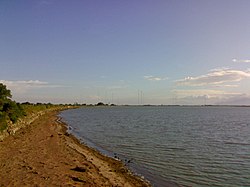INS Kattabomman
| INS Kattabomman | |
|---|---|
| Tirunelveli, Tamil Nadu | |
 INS Kattabomman, VLF transmitting station of Indian Navy | |
| Type | Naval station |
| Site information | |
| Controlled by | Indian Navy |
| Site history | |
| Built | 1990 |
| In use | 1990–present |
| Garrison information | |
| Occupants | Southern Naval Command |
INS Kattabomman is the designation of the VLF-transmission facility of the Indian Navy situated at Vijayanarayanam near Tirunelveli in Tamil Nadu.[1] The facility spread over 3,000 acres has 13 masts, which are arranged in two rings around the central mast. The centre mast has a height of 301 metres, the masts on the inner ring measure 276.4 metres, that on the outer ring measure 227.4 metres.
Two further masts of the station carrying an umbrella antenna are 471 metres tall and the tallest structures in India. They are also the tallest military structure in the world. The facility opened an ELF transmission facility in 2014.[2][3]
History

Development and construction of INS Kattabomman started in 1984 as Project Skylark and costed ₹122 crore (equivalent to ₹11 billion or US$130 million in 2023).[4] It was commissioned into service by Indian President Ramaswamy Venkataraman on 20 October 1990. It is named after king Veera Pandya Kattabomman, who died during the Indian independence movement.[1]
After operationalising the base, India became the seventh country in the world to have developed the Very low frequency communication capability.[5]
Further development
VLF upgrades
On 31 July 2014, a new Very low frequency facility was inaugurated at INS Kattabomman.[6] The upgrade included digitising the control interface.[5]
Extremely low frequency facility
An Extremely low frequency communication facility is also present near the VLF facility, construction of which commenced in March 2012.[3] The facility is used by the Nuclear Command Authority to communicate with the Arihant-class of submarines.[7]
India is the second country after Russia to actively operate an Extremely low frequency facility; the United States had discontinued using it in 2004. Another such facility is proposed in Damagundam Reserve Forest.[8]
See also
- Indian navy
- Integrated commands and units
- Armed Forces Special Operations Division
- Defence Cyber Agency
- Integrated Defence Staff
- Integrated Space Cell
- Indian Nuclear Command Authority
- Indian Armed Forces
- Special Forces of India
- Other topics
- Strategic Forces Command
- List of Indian Air Force stations
- List of Indian Navy bases
- India's overseas military bases
- Veerapandiya Kattabomman
References
- ^ a b "INS Kattabomman". Indian Navy. Retrieved 15 July 2019.
- ^ "Navy gets new facility to communicate with nuclear submarines prowling underwater". The Times of India. 31 July 2014.
- ^ a b "India makes headway with ELF site construction". 28 February 2013. Archived from the original on 23 February 2014.
- ^ "VLF naval communication station INS Kattabomman commissioned in Tamil Nadu". India Today. 15 February 1991. Retrieved 14 December 2019.
{{cite web}}: CS1 maint: url-status (link) - ^ a b "New Commanding Officer for INS Kattabomman". The Hindu. Special Correspondent. 9 June 2017. ISSN 0971-751X. Retrieved 14 December 2019.
{{cite news}}: CS1 maint: others (link) - ^ "VLF Transmitting Station Commissioned at Tamil Nadu". Ministry of Defence. 31 July 2014. Retrieved 14 December 2019 – via Press Information Bureau.
{{cite web}}: CS1 maint: url-status (link) - ^ Unnithan, Sandeep (10 November 2018). "Nuclear Capability: The Arihant Watershed". India Today. Retrieved 14 December 2019.
{{cite web}}: CS1 maint: url-status (link) - ^ "India to be second country to use ELF facility". The Hindu. Special Correspondent. 20 May 2017. ISSN 0971-751X. Retrieved 14 December 2019.
{{cite news}}: CS1 maint: others (link)
Template:Naval establishments of India 8°23′13″N 77°45′10″E / 8.3870°N 77.7529°E
